Ferns are some of the oldest plants in the world. We’re talking about 300 million years of history. What’s amazing is that they grow in such a variety of environments. As a houseplant, they've been cultivated for centuries.
The American Fern Society estimates there are about 12,000 species of ferns. These range from cold hardy to tropical, and range in size from miniature versions to the mighty tree ferns of New Zealand and Australia.
The maidenhair ferns in particular is much loved by Australians, both as an indoor companion plant, or relaxing in a shaded garden with ease. We’ve rounded up the essential facts on how to grow and care for this fern.
We’ve also covered some of the challenges you might experience trying to create the ideal environment for a maidenhair fern to grow, and we’ve thrown in some interesting facts too.
More...
Genus: | Adiantum |
|---|---|
Common Names: | Maidenhair fern |
Family: | Adiantaceae |
Location: | Indoor or outdoor |
Type: | Fern |
Growth: | 30 to 60cm tall, 30 to 60cm wide |
Sun requirements: | Partial sun, shade |
Soil Type | Moist but well-drained |
Soil pH: | Neutral |
Foliage Colour: | Dark green, pink, bright green |
Maintenance level: | Medium |
Poisonous for pets: | No |
Introducing the Maidenhair Fern
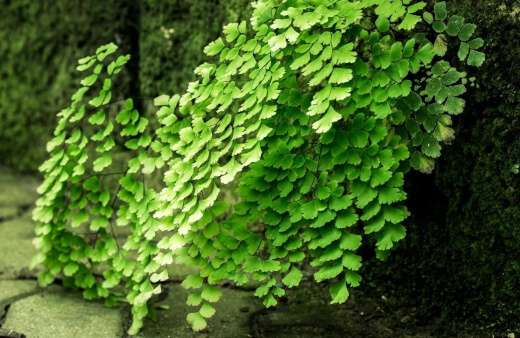
Maidenhair ferns have delicate fan-shaped leaves, grouped together on thin black stems. Their leaves are smaller than other types of ferns. This particular variety is one of the most popular fern houseplants but the maidenhair fern can also be found in nature.
This fern likes taking the road less travelled, growing in places where other plants typically don't, like on rock walls and in between rock fissures where the moisture from water seeping through is what keeps them alive.
Maidenhair ferns are stunning throughout all stages of their growth. They are slow-growing, taking up to three years to reach their full size. This plant is also a bird-safe option and would be perfect to grow beside or near a bird bath to add beauty to your backyard.
Naming and Maidenhair Fern Varieties
Maidenhair ferns are part of the Adiantum genus that includes over 200 varieties of ferns grown around the world. The genus name comes from the Greek word adiantos, which means "unwetted”.
This name is an appropriate description for the fern since its leaves repel water. The plant can literally shed rainwater without getting wet. There are numerous maidenhair fern species, though the most commonly grown include:
Southern Maidenhair (Adiantum capillus-veneris)
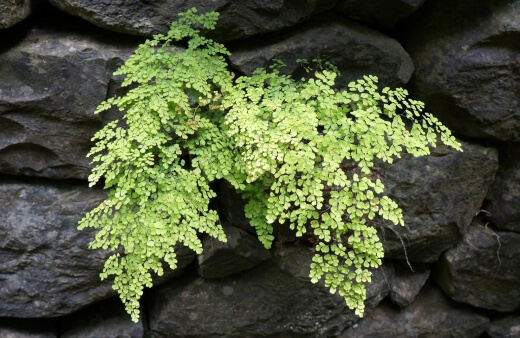
The southern maidenhair fern has fluffy, light, and elegant leaves that can work perfectly in containers or in the ground. It provides a light and airy texture to shady beds.
Rosy Maidenhair (Adiantum hispidulum)
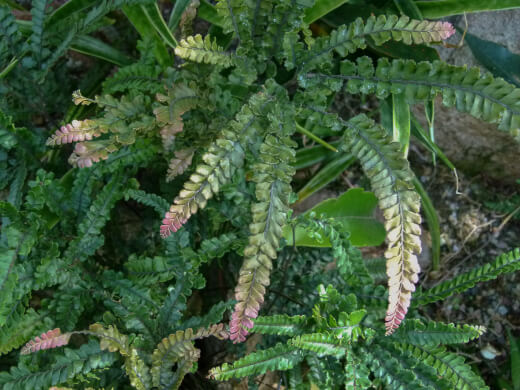
Source: hardyferns.org
This species sprouts new leaves that are a beautiful rose-colored hue that contrasts with the dark green mature leaves and dark green stems.
It will live happily beneath shade trees and if you’re looking to create a lush effect, you can plant a few of these together. It pairs well combined with exotic tropical plants and is semi-evergreen.
Western Maidenhair (Adiantum aleuticum)
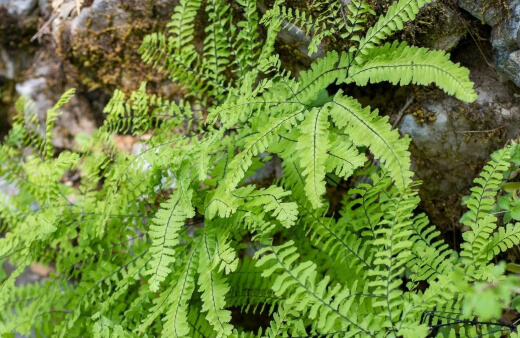
This is an elegant, deciduous fern that has medium sized green leaves on dark brown or black stalks with thick creeping rhizomes. It looks great in a woodland setting or as a shaded border.


Get Your Free Guide:
Master Growing Australian Natives eBook
A Must Have Complete Guide for Every Australian Garden
Get Your Free Guide:
Master Growing Australian Natives eBook
A Must Have Complete Guide for Every Australian Garden
Silver Dollar Maidenhair (Adiantum peruvianum)
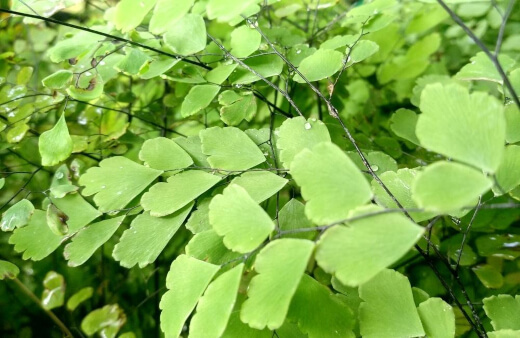
This is definitely one of the prettiest ferns. The Silver Dollar Maidenhair has large leaves with smooth edges. The delicate leaves combined with the shiny black stems really makes for a delightful display.
Northern Maidenhair (Adiantum pedatum)
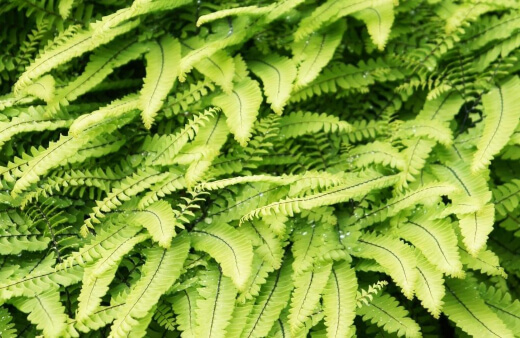
The Northern maidenhair is one of the most sought-after ferns. It is a deciduous fern with gorgeous, black shiny stems and bright green leaves that spread out horizontally in a circular pattern.
Southern Maidenhair |  |
Rosy Maidenhair(Adiantum hispidulum)This species sprouts new leaves that are a beautiful rose-colored hue that contrasts with the dark green mature leaves and dark green stems. It will live happily beneath shade trees and if you’re looking to create a lush effect, you can plant a few of these together. It pairs well combined with exotic tropical plants and is semi-evergreen. |  Source: hardyferns.org |
Western Maidenhair(Adiantum aleuticum)This is an elegant, deciduous fern that has medium sized green leaves on dark brown or black stalks with thick creeping rhizomes. It looks great in a woodland setting or as a shaded border. |  |
Silver Dollar Maidenhair (Adiantum peruvianum)This is definitely one of the prettiest ferns. The Silver Dollar Maidenhair has large leaves with smooth edges. The delicate leaves combined with the shiny black stems really makes for a delightful display. |  |
Northern Maidenhair (Adiantum pedatum)The Northern maidenhair is one of the most sought-after ferns. It is a deciduous fern with gorgeous, black shiny stems and bright green leaves that spread out horizontally in a circular pattern. |  |
Uses of the Maidenhair Fern
People use the maidenhair fern to make medicine. Ailments that it can be used to treat are bronchitis, coughs, whooping cough, and even menstruation cramps. It is also used to loosen chest congestion.
Native Americans used maidenhair ferns to apply to wounds to stop bleeding. It is also used to create luscious locks by applying directly to the scalp to treat hair loss and to make hair darker.
The plant is the source of an aromatic oil commonly used as a shampoo. This is another reason for the name maidenhair. The black stems were once used as a dye but also for the weaving of baskets.
How to Grow Maidenhair Ferns

Maidenhair ferns are delicate plants with tiny leaves that look almost lace-like. They're considered hardy ferns, compared to the ferns that prefer a humid environment.
These ferns can be difficult to keep healthy indoors as they’re quite fussy about their growing conditions. The most important environmental factor to consider when it comes to caring for this fern is humidity.
The maidenhair fern thrives on moisture and needs a lot of it to survive. It can be difficult to get this level of humidity right indoors so managing the delicate balance of this is key.
Light
In their natural forest environment, maidenhair ferns are generally covered by an umbrella of trees. This gives the ferns a bit of shade and partial sunlight. Many people think of ferns as plants that thrive in deep shade when in fact they live in the speckled sunlight of a forest floor.
To successfully grow the maidenhair fern indoors, your aim is to recreate these conditions. Find a spot in your home that gets indirect sunlight only. Avoid harsh light or direct rays. The delicate leaves of the maidenhair fern can burn very easily.
The flip side is that too little light causes poor growth and yellowing leaves. A good tip is to try and find a spot that gets indirect morning or afternoon sun, like a north facing window. Just keep your maidenhair fern out of any drafts. This is a big no for the fern.
It is possible to keep your maidenhair fern in a windowless room. You can provide the light it needs from other sources.
What Soil to Use
Maidenhair ferns like moist but well-draining potting soil. Water is vital to this fern. You can create the ideal growing environment by adding moss or an organic matter like compost into the soil to help it to retain water.
These ferns are used to the loamy ground found in forests and rainforests. Want to find the best soil for your pot? Have a look at our Australian Buying Guide to help you make the right choice.
Temperature and Humidity
Humidity is essential. The maidenhair fern needs very warm, humid air. If conditions are too dry for too long, the leaves turn brown and will start to drop off.
How do you create this happy ideal environment? You can mist the plant with warm water a couple of times a day to maintain the proper moisture levels on its delicate leaves. A good idea is to keep a spray bottle handy and ask family or friends to use it when walking past the fern. This way it becomes less of a chore for you.
You could also place the potted plant near a humidifier or on top of a tray of wet pebbles to lift humidity levels around the plant without letting the roots get soggy.
Looking to invest in a humidifier? We’ve done some research into the best plant humidifiers Australia has to offer.
A bathroom is the type of moisture rich environment that your maidenhair fern would be delighted to live in. It would usually be the most humid room in the house. There is something really uplifting about having natural greenery in the bathroom.
In terms of temperature, the fern needs to be kept above 21 degrees Celsius and should not be placed anywhere in your home where the temperature drops below 15 degrees.
Maidenhair Fern Care
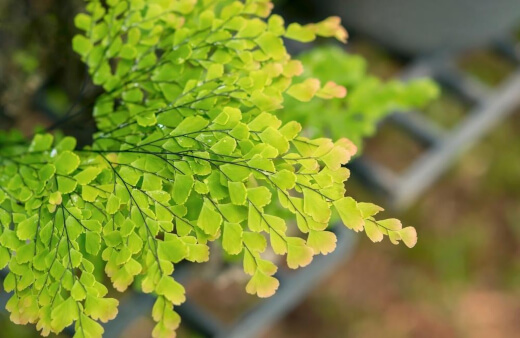
Watering Maidenhair Fern
Your care plan to ensure a thirsty maidenhair fern thrives, is to focus on providing various water sources. Keeping moist soil at all times is a great place to start. In addition to this, water your fern regularly.
You can do this daily or every other day. Make sure you never allow the soil to dry out. As a test, touch the soil and water your fern if the top feels dry. Just be cautious not to let your fern sit in water. You need to keep it damp, not soggy.
Keep an eye out for yellow leaves which are the first sign of overwatering. Moisture is vital to the livelihood of the maidenhair fern but drainage is just as important to prevent root rot.
You could keep the fern in a plastic pot with holes and then place that plastic pot in a nicer looking outer pot if you want to. This is the ideal way to easily check on the moisture levels in the plastic pot, and the drainage holes mean the soil won’t get too soggy.
When you water the fern, you can remove the plastic pot from the larger one and water the plant over a sink until the water stops draining from the plastic pot, before putting it back into the outer one.
What Fertiliser to Use
You don’t really need to fertilise a maidenhair fern. The plant can actually do just fine without it. If you decide to give it an added dose of nutrients, you can feed the fern with a balanced, diluted blend of fertiliser once a month.
A slow-release pellet fertiliser is perfect and you can even add a few drops to the water you use for misting the fern. Avoid any fertiliser that has too much nitrogen which would cause the tips of the leaves to burn. Use 200 ppm or less.
Potting and Repotting Maidenhair Ferns
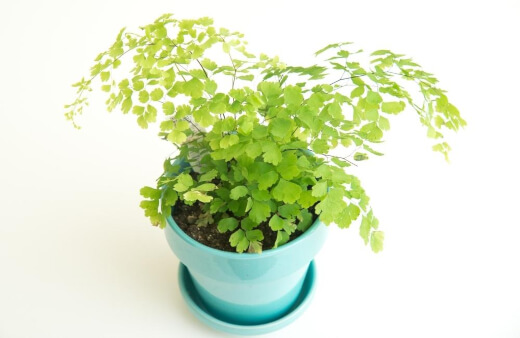
Maidenhair ferns can be repotted annually or biannually. This depends on the pot size and the plant's growth rate. The fern can handle being a little crowded, so you don't have to rush to repot if you're not sure.
Rather wait for the signs that your fern is outgrowing its home, like the roots filling up the pot. To repot a maidenhair fern successfully you can do the following:
- Use a clean, sharp knife or a spade to divide the roots.
- Divide the plant up into more manageable pieces. You need to keep at least two to three healthy fronds on each divided section.
- Plant each section into its own pot and then water them well.
- Don’t fertilise the repotted ferns right away, as this may burn the roots.
How to Propagate Maidenhair Ferns
Maidenhair ferns can be propagated either through division or from their spores. If you want the best chance of success and survival for your young fern, always propagate during the warmer months.
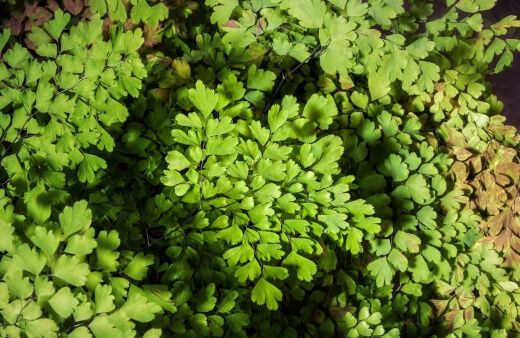
Propagating Maidenhair Ferns by Division
You would begin by taking an established plant and dividing the root ball in half by gently ripping it apart or cutting it. It’s alright if a few leaves die off once you have finished dividing the plant.
Place the new plants into pots and then continue to maintain them as you would the parent plant. A little seaweed extract added at the time of division can really help the plant deal with any trauma caused by the division process.
Make sure the new pots you are planting in aren’t too big. A good guideline is to choose a pot that is a bit bigger than the new root ball.
Maidenhair Ferns Propagation via Spores
Ferns don’t produce flowers or seeds. They have something unique - they create spores. Propagation using spores is quite easy. You will know your plant is ready to produce spores when you see the sori (little brown dots on the underside of the leaf tips).
Cut off a few fronds with the sori and place them between two pieces of paper. You can leave it somewhere safe for about a week. The spores will drop onto the paper. You can then spread them over soil in a small pot.
Cover the top of the pot with plastic wrap to create a greenhouse effect and just make sure it’s not in direct sun. Keep the soil moist and after a few weeks you will begin to see the gametophytes peeping through.
Fern gametophytes are free living and they need moist conditions to reproduce. After fertilisation of the gametophyte, the sporophytes (young ferns in the making) will start to appear.
Common Pests and Problems with Maidenhair Ferns
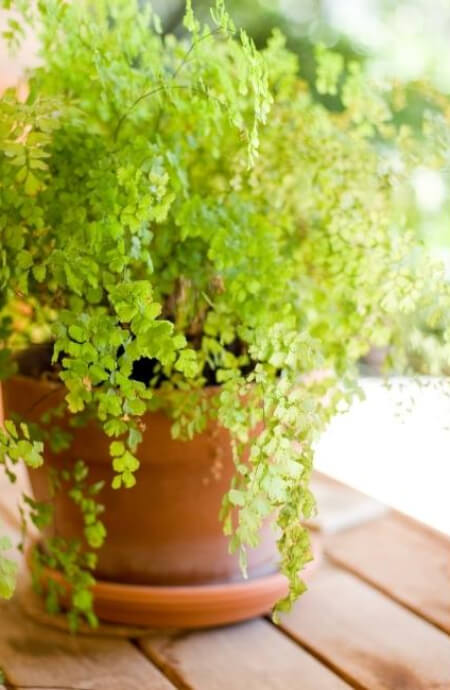
Luckily, only a few insects think the maidenhair fern makes a delicious snack. Scales and mealybugs can attach themselves to the leaves. Check your plant often and you can treat any unwanted visitors with insecticidal soap.
The small leaves of maidenhair ferns are very sensitive. You'll need to hunt for the perfect indoor spot for the plant (keeping all our tips in mind). If the spot you choose is less than ideal, the leaves will let you know it’s time to relocate.
If the air is too dry and the plant needs more moisture and humidity, you might notice that the leaves curl up, dry out or brown at the tips, and sometimes fall off. If you are dedicated to removing the curled and dried leaves, it can help the fern grow even denser foliage.
Maidenhair Ferns FAQs

Are maidenhair ferns easy to grow?
Maidenhair ferns are not really thought of as high-maintenance houseplants. The tricky bit comes in when you are trying to get the growing conditions right.
If you manage to achieve proper indoor growing conditions, the fern can be quite an easy guest that is worth adding to your houseplant collection.
How fast does maidenhair fern grow?
This fern grows quite slowly and usually takes up to three years to reach full size. This means you won't need to repot it too often.
How long can a maidenhair fern live indoors?
As long as you find the right spot and don’t move the plant too much, it should be able to live happily for many years as an indoor plant.
Why is the maidenhair fern called that?
The nonscientific name "Maidenhair" apparently comes from the black roots that grow from the rootstock, which are thought to look a bit like hair.
Do maidenhair ferns purify the air?
Ferns in general are fantastic for removing pollutants from the air.
Is the maidenhair fern native to Australia?
There are around two hundred species of maidenhair ferns that are native to the tropical regions of the world, in particular South America, but there are also many that are native to Australia.
Of all the ferns that are grown in Australian homes, the maidenhair is by far one of the most popular choices. (See our list of Australian native ferns for more options to choose from.)
Are maidenhair ferns epiphytes?
In their natural habitat, these ferns are either lithophytic (growing out of cracks in rocks) or terrestrial (growing out of the ground). Maidenhair ferns are not however epiphytic (growing on the surface of another plant) like some other popular ferns.
Is the maidenhair fern toxic to dogs?
Plants that are considered 'true ferns' such as the Boston, maidenhair, bird's nest and staghorn ferns are all considered non-toxic for pets.
What are the bumps on the back of fern leaves?
Ferns are an ancient group of plants that date back about 300 million years. They have an incredible way of reproducing from microscopic spores rather than seeds.
The bumps that you see on the undersides of the leaves are spore cases, called sporangia.
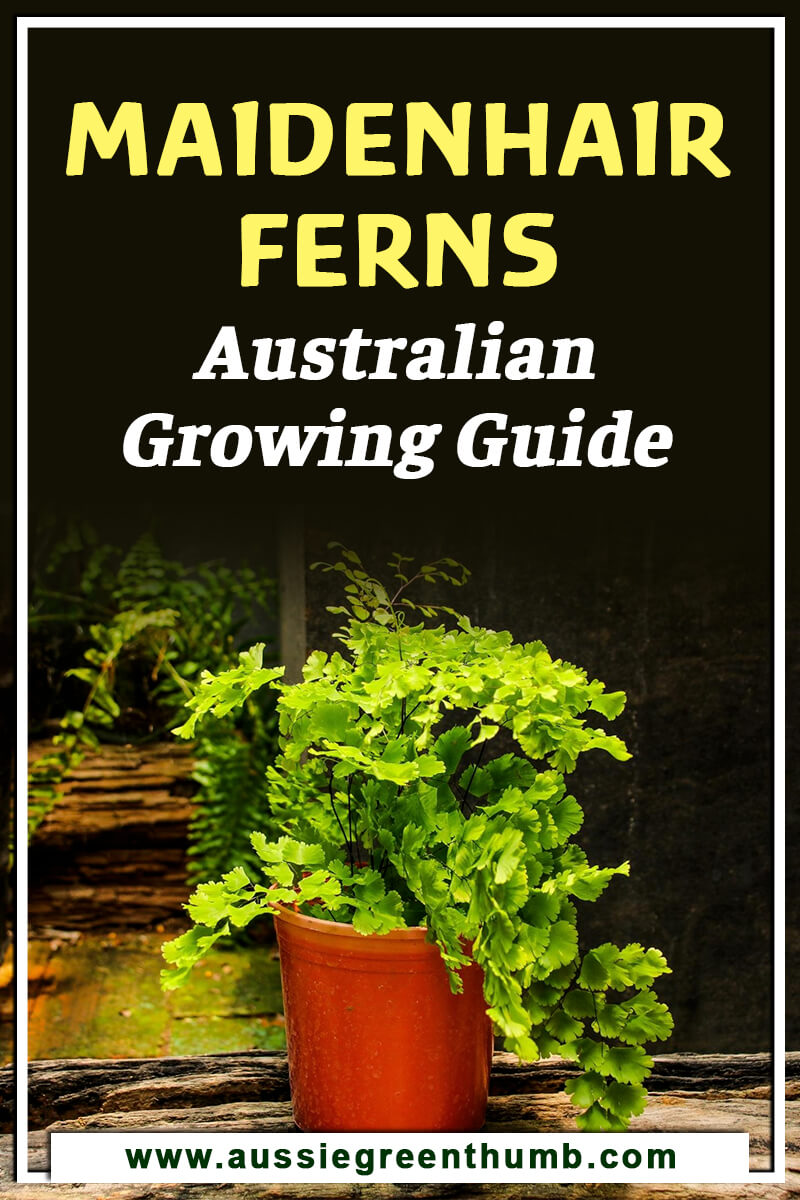
Enjoy Growing Maidenhair Ferns
Maidenhair ferns seem to be worth the trouble of perfecting their growing environment. They are pleasing on the eye with their lush leaves and are versatile as either an indoor or outdoor choice.
Homes across Australia boast this houseplant because it just seems to compliment any indoor space. Your steamy bathroom is the plant’s delight and you might just end up with a green oasis to relax in.
Keep the humidity high, the sun exposure low, and the watering somewhere in-between, and you’re bound to have a happy, healthy maidenhair ferns for years to come.
Published on March 15, 2022 by Maisie Blevins
Last Updated on February 21, 2024





Hi Michael,
Hope you are doing well. Do you have Facebook account? If you do, please post an image of your maidenhair on our Facebook page so we can see how we can help you.
If that’s not an option, please send it via email to [email protected].
Best regards,
Gary Clarke